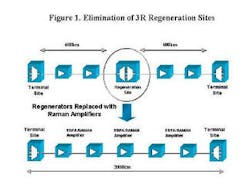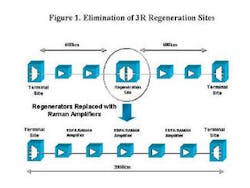By CATHY FRANCIS
Cisco Systems
Optical networking technologies have brought about radical changes and revolutionary possibilities for long-haul optical transport. Service providers are driven to continually lower the cost per bit per kilometer while maximizing fiber usage and increasing service velocity to meet customer demand. Service providers are continually evaluating solutions that lengthen spans, increase capacity, and enhance performance.
While technology advancements are overcoming the constraints that previously hindered cost-effective long-haul optical transport, market drivers in today's complex optical core are converging to form distinct segments around which service providers are designing their networks. These segments include conventional long-haul (LH), which serves spans of fiber between signal regeneration devices of up to 600 km; extended long-haul (ELH), supporting spans of 600 to 2,000 km while reducing network costs; and ultra long-haul (ULH), which supports spans of over 2,000 km and is best suited for the all-photonic network of the future in which photonic switching plays a key role in the backbone. While traditional views have broken the core transport market into two segments, the LH and ULH, the third -- the Extended Long-Haul -- is emerging as the sweet spot for long-haul transport where service providers can maximize channel count, speed, and distance.
Market drivers
The face of long-haul optical transport today is changing due to three primary market drivers: evolving traffic patterns, cost pressures for service providers, and new technology enablers.
Early on in its development, long-haul optical transport technology allowed spans of up to 600 km between 3R regeneration devices, which reconditioned degraded optical signals as they traveled along the fiber network. For much of the decade, this proved adequate. Today, however, the once voice-centric network carries a preponderance of data/IP traffic. Studies reveal that voice traffic typically travels around 600 km before being terminated, while data traffic averages more than 2.5 times that -- 1,600 to 1,700 km. For a sizable portion of the long-haul market, spans of 600 km are no longer adequate.
Meanwhile, service providers are under continual pressure to reduce costs, both in capital expenditures (CapEx) and ongoing operational expenditures (OpEx). In long-haul networks the objective is to achieve the lowest cost per bit per kilometer, and each additional piece of equipment or network inefficiency can significantly affect both CapEx and OpEx.
For example, consider deploying a long-haul optical transport system between two cities approximately 1,800 km apart (see Figure 1). A conventional LH system would require three cascaded regeneration sections of 600 km each to establish the connection.
In terms of equipment, this means two terminal sites at the link ends, 21 amplifiers and two sites for optical/electrical/optical (OEO) 3R regeneration conversion. Depending on the number of channels and their bit rate, regenerators can be very expensive (10 to 20 times the price of an amplifier site), accounting for a significant part of the total investment. Increasing the maximum non-regenerated distance to minimize the number of costly 3R regenerators provides a cost savings of as much as 30 percent or more.
With longer spans and fewer network elements, OpEx is also greatly reduced. Operation, administration, maintenance, and provisioning (OAM&P) costs for service providers can account for nearly half of total overhead, as verified in a recent study (seeFigure 2).
Fundamentally, fewer devices reduce complexities in management, provisioning, and maintenance, which subsequently reduce operational expenses. Therefore, when installing and provisioning a new channel on the system, there is less need for trained technicians to travel to remote locations, since transponders are located only in terminal sites and regeneration sites. Human intervention is minimized via integrated management and operational functions and time-to-service is reduced, resulting in shorter time to revenue for the service provider.
Additionally, the replacement of OEO regeneration sites with optical line amplification (OLA) sites reduces both the floor occupancy and the power consumption required to operate the system. Finally, the elimination of regeneration sites means fewer electronic conversions and fewer points of failure, increasing reliability, availability, and serviceability.
DWDM has greatly improved the efficiency of optical transmission and has become a key element to any low-cost, high-capacity transmission network. Pushing beyond 600 km in DWDM networks, however, has historically been hindered by the inherent limitations of optical fiber, such as chromatic and polarization-mode dispersion (PMD), attenuation, four-wave mixing, and cross-phase and self-phase modulation.
Today, a number of new technologies such as distributed Raman amplification, forward error correction (FEC), and dispersion-managed solitons are making longer spans a reality. Distances of up to 4,000 km have been demonstrated in laboratory environments.
Addressing the market
As these market drivers converge and stretch the span of long-haul DWDM optical transport systems, the long-haul market in effect becomes divided, creating the three distinct segments mentioned previously: LH, ELH, and ULH. While many system vendors are focusing on ULH, the ELH solution is a better-suited, cost-effective solution for transmission requirements over the next two years or more, given a large percentage of transport traffic in the network core is forecast to be in the 600- to 1,700-km space.
In fact, research of actual traffic flow patterns in carrier networks (seeFigure 3) shows the majority of traffic, particularly in North America, concentrating around the LH (approximately 45%) and ELH (approximately 51%) spans, with a small percentage occurring at spans over 2,000 km (ULH).
As this research shows, conventional LH transport continues to be an area service providers address on behalf of their customer base. LH is particularly well suited for optical core networks in the eastern part of the United States, Europe, and generally speaking where cities tend to be in close proximity. The European backbone network, for example, is built over short spans through dense-meshed SDH-based networks, as large cities are typically between 70 and 100 km apart. Conventional LH systems will continue to be ideally suited for such network topologies. Furthermore, even though carriers migrate to ever increasing data service offerings, voice traffic will continue to be an important revenue source driving LH traffic.
ULH, as a second segment fits the market for coast-to-coast "express" type traffic. However, proprietary technologies, a small market demand, and an overall higher cost of deploying and operating ULH spans to meet the requirements of ELH traffic make this a cost-prohibitive solution for many service providers. Many vendors and service providers also are evaluating ULH to meet future demands for all-photonic networking, which will likely become a reality in the long-haul space in the 2004 timeframe.
ELH systems, on the other hand, enable service providers to cost-effectively build to market needs today without overspending on technologies that may not be required. Specifically, ELH systems possess a number of significant technical and cost advantages:
- ELH systems can be designed and built with standard, off-the-shelf components using nonproprietary technologies, such as the standards-based FEC for which economical ASICs are commercially available.
- Amplifier spacing in ELH systems are similar to those in LH systems in that distances of 70 to 80 km between OLA sites are the norm. ULH systems that use dispersion managed solitons typically require shorter amplifier spacings of approximately 50 km to mitigate the effects of power fluctuations, thus increasing the total number sites in the network.
- Transmission coding for ELH systems is non-return to zero (NRZ), requiring only one modulation stage instead of two. Most ULH systems, for example, use proprietary dispersion managed solitons with RZ transmission coding. RZ transmission coding requires dual-stage external modulation: one stage for creating a stream of pulses and another for encoding the generated pulses in an RZ format. This adds to the overall cost.
- While PMD effects cannot be neglected in distances in the 4,000-km range, PMD compensators are not required for ELH systems because optimized receivers are capable of tolerating the PMD effect over 2,000 km of relatively new fiber plants.
Summary
As service providers grapple with the uncertainties of today's inclement economic climate, cost reduction is of paramount importance. Carriers designing long-haul optical transport networks need to increase performance and capacity to create new revenue opportunities with cost-effective solutions that maximize tight CapEx and OpEx budgets.
Created through evolving traffic patterns, enabled by new technologies, and required by cost pressures, the ELH segment has emerged as the focal point for cost-effective long-haul optical transport over the next two years or so. Deploying systems that target the 600- to 2,000-km market segment, service providers can cost-effectively maximize channel count, speed, and distance to accelerate service velocity and time to revenue.
Cathy Francis is senior manager, market development, within the Photonics Business Unit of Cisco Systems (San Jose, CA).
Return to Figure 2 referenceReturn to Figure 3 reference

